
cocoaModem Contesting
Kok Chen, W7AY
[w7ay@arrl.net]
Last edited: January
26, 2007
-
Contest Interface
- Macros Buttons
-
Contest Interface Macros
- Contest Info Sheet
- Selecting a Contest
- Saving a Contest Session
- Resuming a Contest Session
- Personalizing Your Own Contest
Template
- Contest Journaling
- Switching between the Contest interface
and the normal cocoaModem interface
-
Contest Log
- Creating a Cabrillo log
- Implemented Contests
- Macros Buttons
-
Quick Guide - Contesting Checklist
- Before the contest - Preparations
- During the contest - Operating
- After the Contest - Generating a
Cabrillo Log
- Recovering from a crash
Contest Interface
cocoaModem has an incidental Contest Manager that is sufficient for basic contesting. For serious contesting, I recommed that you use a specialized contest program instead of cocoaModem.
This Contest Manager provides a special user interface in place of the interactive transmit views for each of the supported (RTTY, PSK only) contesting modes.
Instead of a text view to type into, this alternate user interface consists of text fields for received call sign and received exchanges, and buttons for transmitting sent exchanges, together with fields that track the QSO number, time, etc.. The contest interface comes with its own set of macro buttons that are distinct from the mode (RTTY, PSK, etc) macros. With multi-moded contests such as the ARRL RTTY Roundup for example, where both RTTY and PSK31 are allowed, the modes share the same contest macros.
Notice that there is no Transmit button in the contest interface. You would typically insert a %[tx] inside a macro to command cocoaModem into the transmit mode. If you really need to have a transmit button, you can always reserve one of the macro buttons for it, with just %[tx] in the macro body.
While there is no transmit button, there is a Cancel button in the contest interface. This button flushes whatever has not yet been transmitted and the returns cocoaModem to the receive mode. If there are multiple macros queued up, all un-transmitted text will be flushed.
You can quickly switch between the contest and the interactive interface, in case of fills, a quick chat, etc, by going to the main menu bar and pull down on the Interface menu. From there, you can select either the interactive interface or the contest interface or to toggle between the two. You can also toggle between the two interface modes by using the keyboard shortcut command-I.
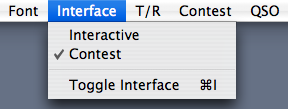
Macro Buttons
In the contest interface, the macro buttons are associated with six sets of macros rather than the three sets (normal, option and option-shift macros) under the "normal" interactive interface. This is because the contest interface provides for a separate set of 3 (normal, option and option-shift) macros for a “CQ mode” and another 3 sets for the “Search and Pounce (S&P) mode.”
You need not use all 6 sets, but they are all available for your use. The only difference between the CQ and S&P modes is just in which set of macros is used by the interface.
The reason the different sets are there is because a typical exchange is different for a CQ station and a S&P station, for example (red text is a CQ’ing station, blue text for S&P station):
CQ Contest de W7AY W7AY CQ
de AA6TY AA6TY
AA6TY 599 OR OR AA6TY
W7AY TU 599 CA CA de AA6TY
AA6TY QSL es TNX QRZ? W7AY
Thus, an exchange macro might in CQ mode look like
%[tx]\n%C 599 %s %s %C\n%[rx]
while the same exchange macro might in S&P mode look like
%[tx]\n%C TU 599 %s %s de %c\n%[rx]
If you have assigned these two messages to two different macros, one that you use while in CQ mode and one that you use in S&P mode, you would not have to remember which button to press depending on whether you are answering a call or initiating a call.
In the example above, where you create a different exchange macro for CQ and S&P, you can assign them to the same macro name, e.g., “EXCH” and at the same button location. To send an exchange, you can simply always hit that same button whether you are in CQ or S&P mode.
Remember that there is no transmit button in the contest interface. You initiate transmission with a macro that has %[tx] in the body, or by using the keyboard shortcut for Transmit (command-T) that is in the T/R Menu in the menu bar. The philosophy of the contest panel is to have as few buttons as possible so as to reduce confusion during the rapid fire contest exchanges.
The following are macros that are often used in contests, defined in the contest info section of the User Info sheet.
%a ARRL Section %g Grid Square %s State/Province/DX %y Year first licensed %z CQ Zone number %Z ITU Zone number
Contest Interface Macros
The following are macros that recalls the information that are built into the contest interface
%C the received callsign (callsign text field) %n QSO number of the current contact %o zero "cut" number (T=0) of the current contact %N "cut" number (A=1,N=9, T=0) of the current contact %p “previous” QSO number %t UTC hhmm %T “registered” UTC %x ARRL Roundup exchange (%n or %s depending on if we are DX) %X the received exchange (exchange text field)
- Received Call sign (%C)
The received call sign is either manually entered or control-clicked into the received call sign field. The call sign is fetched using %C. Notice the uppercased C -- the lowercased c fetches your own callsign that is in the User Info panel; see the documentation in the main User’s Manual.
The cocoaModem contest interface has a unique feature that I call "freeze-click."
cocoaModem uses the right mouse button (control-click) to capture call signs and contest exchanges. When there are carriage returns being decoded into the exchange textview, it is often tricky to rapidly capture a call sign, and you often ending up clicking on blank space, or even worse, something that is not a call sign.
With "freeze-click," a right mouse button down does not capture the call sign. Instead, when the button is held down, new text characters are blocked from appearing in the exchange textview. As long as you hold the right mouse button down, the exchange textview will remain frozen. You can now at your own leisure move the cursor and release the right mouse button when the cursor is over the call sign (or contest exchange). The action of releasing the right mouse button captures the call sign, and allows decoded characters to resume filling up the exchange textview. No decoded text is lost while the mouse is held down; they are just buffered away.
- QSO Numbers (%n, %3n, %4n)
%n adds the contact number into transmitted stream. Note that you can format the number. %n will send the minimum number of digits needed to make a number. QSO 1 will be sent as “1”. QSO number 99 will be sent as “99”.
There are two variants of %n -- %3n and %4n.
In the case of %3n, numbers will be sent with 3 or more characters -- all numbers less than 100 will have zeros prepended. For example, QSO number 1 will be sent as “001”, QSO number 99 will be sent as “099”, and QSO number 100 will be sent as “100” and QSO number 1001 will be sent as “1001”.
In the case of %4n, numbers will be sent with 4 or more characters -- all numbers less than 1000 will have zeros prepended. For example, QSO number 1 will be sent as “0001”, QSO number 999 will be sent as “0999”, and QSO number 1000 will be sent as “1000”.
- Zero "Cut" Number (%o, %3o, %4o)
(Note: %o = percent followed by the lower cased letter o)
Same as %n, except the letter T is substituted for the number 0.
Please note that there is no special check to see if you are in the CW mode. Please do not use cut numbers in RTTY or PSK31 macros.
- "Cut" Numbers (%N, %3N, %4N)
Same as %n, except the letter A is substituted for the number 1, the letter N is substituted for the number 9 and the letter T for the number 0.
Please note that there is no special check to see if you are in the CW mode. Please do not use cut numbers in RTTY or PSK31 macros. An RST of 599 should be be sent as 599 and never as 5NN.
- QSO Time (%t, %T, %P)
You can fetch your current computer’s clock that is converted to UTC using the %t, %T or %P time macros.
All of the time macros will return a 4 digit number. The %t macro returns the current UTC time and uses the same clock that appears in the contest interface itself.
However, do not use %t when the contest exchange asks for a time field. Use the %T (upper case T) or the %P (upper case P) macros instead.
There are occasions when you are asked to transmit a "fill" (a repeat of a contest exchange). If the exchange includes a time field (for example, in the BARTG HF contest), the time that is fetched using %t could have changed between the original exchange and when %t was fetched the second time.
For the purpose of sending exchanges (and also the time stamp to log the contact), cocoaModem uses a “registered” time -- the %T (upper case T) macro.
The registered time is updated from the “wall time” whenever
- you clear the QSO fields using the CLR button, or
- you have completely entered the call sign
manually and have advanced to the next field (i.e.,
typed the call sign and then tabbed to the next
field), or
- captured the call sign using a control click.
The “registered” time is also the time that is logged locally as the exchange that you have sent for contests such as the BARTG HF contest. By consistently using %T everywhere, the time is sent and logged at the other end will be the same time that is sent to your own log, making the two logs agree.
There is a third time macro %P (upper case P) that can be used instead of %T. The usage of this is similar to the “previously logged QSO number exchange” (see below).
The time field for %P is updated from %T each time a new call sign is entered into the call sign field (a call sign that is typed and tabbed to the next field, or a call sign that is entered with a control click).
Like the %p (lower case p) for the QSO number, allows you to repeat an exchange to someone after you have logged and clear the QSO fields. %T is probably more appropriate for S&P mode, and %P might be useful when you are CQ’ing.
- Previously Logged QSO Number (%p)
When you log a QSO (by hitting the Log button or using the Command-L keyboard shortcut), the fields of the contest interface are set to a default value (usually with all fields cleared except for the RST field, if one is present).
The local QSO number is also incremented by one.
There are cases that after logging and incrementing the QSO number, someone will ask for a repeat.
If this happens a lot to you (it really depends on your own habit of when you actually hit that log button), you might want to use the %p (“previous number”) macro instead of the %n (“number”) macro when you are CQ’ing.
%p behaves like the %n macro if the call sign field is not empty -- it will return the current QSO number that you see in the contest interface.
If the call sign field is empty however, %p sends the previous number (i.e., [%n]-1).
When you use %p, you need to be careful not to send an exchange for a new QSO before you have entered something into the call sign field.
A note here also about the %C and %X macros – if the call sign field is empty, cocoaModem will use the most recently logged call sign when you ask for %C. If the received exchange field is empty, cocoaModem will use the most recently logged exchange for %X.
Keyboard Shortcuts for Contest Macros
As with regular macros, you can use to command-number keyboard shortcut to invoke the macros when you are in the Contest interface. Typing Command-1 is the same as clicking on the first macro button, typing Command-2 is the same as clicking on the second macro button, etc. To access the tho other macro sheets, use option-command and shift-option-command modifier keys.
Automatic Repetition of Macros
Once you enter the Contest Mode, you will notice that even if you had previously turned it on, the QSO Info bar at the bottom of the window disappears. Instead, it is replaced by some useful items when you are in the CQ mode (the space is reserved for something else in the future that I have in mind for S&P mode). Instead of the QSO Info strip, the right side of the strip contains objects for controlling the repetition of macros (see figure below).

Controls for Repeating Macros.
The popup menu that shows up in the above figure as Last Used contains a list of macros names (eight macros, eight option macros and eight option-shift macros). If Macro #1 had been previously selected, hitting the Repeat button will send that macro if it is not already being sent. Once cocoaModem enters the receive mode again, it will pause the transmission for the number of seconds selected in the “pause” number field. cocoaModem defaults to 2.7 seconds but you can choose any pause value between 0.5 and 10 seconds. The pause value you select is saved to the plist file when you leave cocoaModem.
When the pause period is over, cocoaModem automatically reinitiates the macro that is selected in the menu. The small indicator between the Stop button and the Repeat button will turn orange when the repeat is in effect.
The automatic repeats terminates when any keyboard or mouse activity is sensed (pressing the Stop button is fine, too). The repeat terminates even when you press on the command or option keys, or click on a call sign in the receiver’s textview.
Thus all you have to do is to click on the call sign of a caller while you are in a CQ repeat loop and immediately send an exchange without bothering to press the Stop button.
If the macro repeat sequence is terminated by the operator while cocoaModem is in the middle of the transmission of a macro, the stop is immediate; cocoaModem does not wait for the message to complete (i.e., the stop behaves like a flush-and-return-to-receive command).
If you had selected Last Used in the repeating macro menu, cocoaModem will issue the most recently used macro, instead of a fixed macro from the menu. This may be appropriate and in fact useful in many instances but be forewarned that “last used” means precisely that – if the macro that you have last issued was a contest exchange, that exchange will be repeated over and over!
Contest Info Sheet
The Contest Info dialog sheet (Figure below) is brought up by selecting Contest Info in the Window Menu in the Menu Bar. The Contest Info sheet contains contest specific information that is needed to create a Cabrillo log and some fields (such as the Call sign used field) are used by macros during the contest itself.
The information here is stored in unencrypted form in your cocoaModem Preference file. Be sure you don’t put anything in here that you won’t want anyone else to read.
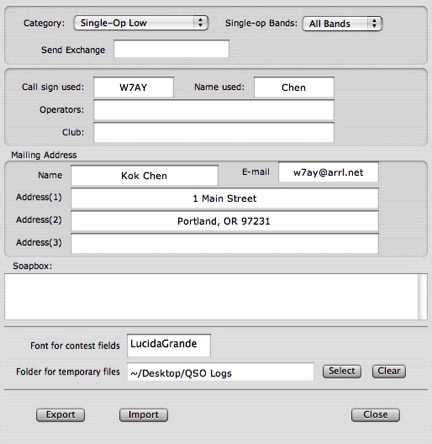
Contest Info SheetBefore you operate a contest or ask cocoaModem to create a Cabrillo log, you must update the information in this sheet (and also checking to make sure the contest related field in the User Info sheet are appropriate).
The Category menu at the top of the contest Info sheet lets you select the category in which you are entering the contest (single/multi-op, high/low power). If you have selected a Single-op category, you will also have to select an appropriate item in the Band menu that is next to the Category menu. If you have selected one of the multi op categories, you need not bother with the Band menu.
You need not bother with the Send exchange; leave this field empty for the contest which cocoaModem supports. This field is used for generating the exchange field in Cabrillo for contests which cocoaModem does not support.
If the Call sign used field is not empty, it is used in place of the call sign that is in your User Info sheet. This is typically used if you have a special contest call sign, or if you are a guest at someone else’s station. The name used field is only used in contests where a name is part of an exchange. During NAQP, people often use fictitious names – Monica, Bubba and Dubya were popular in the recent years.
The Operators field is used to list the call signs of the different operators (use space separated call signs, e.g. “AA6TY AH6OZ W7AY”, but without the quotes). It is also acceptable to enter just a single call sign, even when it is the same as the Call sign used or the call sign in the User Info sheet.
The mailing address is needed in the Cabrillo entry in case you have won a certificate or trophy.
The Soapbox field is to include comments to the contest sponsor. This should be short; certainly no more than three sentences. QST often publishes these soapbox comments when contest results are published.
The Font for contest fields is used to select the font that appears in the contest panel. cocoaModem defaults to some reasonable font and size, but if you have your favorite font or need a larger size, select this field and then select the Show Fonts item in the Font Menu in the menu bar (or, as with other Cocoa applications, you can type option-command-T on the keyboard to bring up the Font picker).
The Folder for temporary files shows the folder that you have selected for contest journaling. cocoaModem default to an empty field, which means that no temporary files will be generated. It is highly advisable that the first thing you do is to select a folder for storing cocoaModem temporary files. The dialog panel that you open when you hit the Select button allows you to create folders (button at bottom left hand side of the file dialog) so you need not create folders beforehand. The clear button clears the temporary folder field and cocoaModem will not generate any temporaries. Read the section on journaling to see the importance of creating this folder.
Finally, just as with macro sheets, you can save and restore the information in the Contest Info sheet by using the Import and Export buttons.
To close the sheet, use the Close button at the bottom right of the Contest Info sheet.
Selecting a Contest
To start working a contest, you will first need to create a contest database for yourself. The database will maintain a log and will keep track of duplicates contacts, etc. (In the future it will also report a running total score, running multiplier count, etc.) The database also contains any personalization of the contest macros, etc.
There are two methods to create a new contest database.
The first method is to select one of the default contest templates from the submenu New in the Contest menu in the menu bar.
By selecting a contest template from New, you will be starting with a completely blank prototype, together with some appropriate defaults and macros. You do, however have to fill in the fields in the in the Contest Info sheet, since the shared contest template will obviously not know data that is specific to you.
A second method to create a contest database is to use the Resume… function in the Contest menu. You can also use Resume… to start a personalized contest template (one that has your own macros).
Saving a Contest Session
When you select Save As… in the contest menu, the contest database is saved away into a contest archive file.
In general, a contest archive is an XML file that has all the data that is contained in the contest template that New generates. In addition, it contains the information that is in your Contest Info sheet, and also a log of your QSO and the saved archive file also has any changes you have made to the macros.
If the contest database has not been archived when cocoaModem is asked to quit, cocoaModem will flash a warning alert asking you to first save the session. Since the session includes the contest macros, any changes you have made in the contest macro sheets will be considered a change of the database and you will need to Save the session before you can quit cocoaModem.
Even if you don’t need to save a session, as a precaution you will still have to save the session to some temporary file which you can later delete, before you are allowed to quit the application. (Though not advisable, a system Force Quit will abort cocoaModem from requiring you to save an archive).
Selecting Save instead of Save As… in the Contest menu will save a contest archive into the file name that is selected by the most recent Save As… .
The saved contest archive file encapsulates your contest session from the start (QSO number 1) up to the time you have last saved it. It can be used later to resume a contest session after taking a break for example, or to later create a Cabrillo log. Treat Save the same way you do system backups – i.e., do it as as often as you can without slowing you down.
The contest archive is an XML file (although not in the same format as the plist files). It can be read by any text editor such as TextEdit or BBEdit. Although not recommended for someone not familiar XML files, you can make changes in the archive by making changes with the editor – just be mindful that the XML tags should remain unchanged.
We shall see later that a contest template is nothing more than a contest archive that has no QSO entry.
Resuming a Contest Session
Resume… allows you to open a previously saved contest archive. By resuming a contest archive, you are basically setting the contesting state of cocoaModem to the state when you had created the archive.
You can also use Resume… to read a contest archive to create a Cabrillo log long after the contest has ended.
Resume… restores your Contest and Cabrillo information and the contest macros to when the archive was created. Any changes you make to your personal information, the log or the contest macros will be included in the next Save that you make.
Personalizing your own Contest Template
A contest template, such as the default one that you load with New is really just a contest archive with no QSO data in it. In fact, if you open the cocoaModem application bundle (control-click on the cocoaModem app and select Show Package Contents) and navigate into the Contents/Resources folder, you will find the xml files that New used as the default contest templates. New is simply implemented a Resume command in cocoaModem, but one that always pick a file from the application bundle, and using the contest name that is selected in by the user.
If the default macros from the contest template in New is not suitable for you, you can create your own contest template in the form of a contest archive which has no QSO in it by performing the following steps:
- launch a new session of cocoaModem
- select a contest template from New in
the Contest menu of the Menu Bar,
- make changes to the contest macros, or import the
macros from that has been exported from a prior
contest,
- check and update all the field in the User Info
and Contest Info sheets,
- select Save As… in the Contest menu.
Step 5) will save a personalized contest template for you. The suggested Save As… name is in the form of “Contest Year.xml”. Remove the year from the name before saving. In the future you can use Resume… in the Contest menu to fetch this template instead of using New.
It is advisable that you create a personalized template before the contest starts. That way, all you need to operate in the contest is to use Resume… and off you go.
Contest Journaling
cocoaModem has the facility to create an entry into a journal file each time you log a new QSO. To do this, you must first set up the folder to journal into. I recommend that you turn journaling on in all instances unless you have a very slow hard drive; cocoaModem accesses the hard drive for every log entry that you make when journaling is turned on.
To set up the journal file folder, open the Contest Info dialog sheet from the Window menu in the Menu Bar.
You will see a field that is labeled “Folder for temporary files.” If this field is empty, cocoaModem will not perform any journaling. Use the Select button to enter a dialog for selecting the temp file folder.
If you want to stop journaling, simply clear the entry in the “Folder for temporary files” field using the Clear button.
A journal file has a name in the form
cocoaModem 2004-12-11 1645.txt,
where the numbers indicate the date and time the file was created (at the start of a contest session).
A journal file is a partial XML file, and is humanly readable and editable as long as you know about XML tags. Make sure you make a copy of the journal file before attempting to edit it. A journal file is an almost complete cocoaModem log file that has Cabrillo info, contest macros and QSO information. The only things missing in the journal file are two XML end tags.
The reason for maintaining a log by log journal is of course in case cocoaModem or MacOS X crashes before you have a chance to perform a save.
To restore from a journal file, use the Resume… item in the Contest menu as if you are resuming a contest log. Each journal file has an entry which tells cocoaModem to add the end tags before using it.
Switching between the Contest interface and the normal cocoaModem interface
In the contest mode, cocoaModem replaces the transmit view with a user interface which is specialized for contest usage. The receive views do not change. However, you will notice that the Transmit and Flush buttons are missing in the contest interface. That is because the intent is that you make use of the %[tx] and %[rx] macros to control the fast turn around of contest transmissions. Typically, you would have a CQ macro which reads
%[tx]\nCQ Test de %c %c %c CQ\n%[rx]
Thus pressing the CQ macro button will automatically place cocoaModem into transmit mode, send the CQ message and turn cocoaModem back to receive mode once the message has gone out. There is no need for a transmit/receive button.
There is also no Flush button. Instead, the contest interface provides a Cancel button, which has the function of a flush together with returning cocoaModem to the receive mode.
There will be times however, when you would want to exchange messages that are not pre-canned into contest macros (having a short QSO with a friend in the middle of a contest, sending "fills" that you have not preprogrammed into macros, for example). To doing this, you can switch cocoaModem between the contest and QSO interfaces. Under the Interface menu in the Menu Bar are two items named Contest Interface and QSO Interface. By selecting QSO Interface, you will get back the familiar transmit view, together with the Transmit and Flush buttons. You can resume the contest interface anytime by selecting Contest Interface in the Contest menu.
There is also a toggle item in the Interface menu to switch between the two interfaces. The interface toggle function has the keyboard shortcut command-I.
Contest Log
cocoaModem contains a log that has a hashed table of call signs. Each table entry is associated with a linked list of all the QSOs made with that callsign. This is the mechanism for keeping the contest log. This log can be viewed, searched and edited from a TableView.
Displaying the Log
Use Show Log in the Contest menu of cocoaModem’s Menu Bar to display the log. This is the familiar view used by Mail.app. The figure below shows the Contest Log.
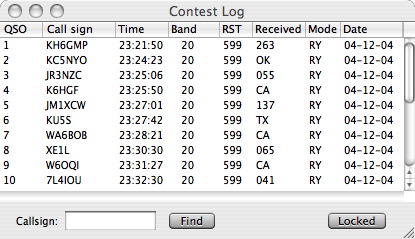
Contest Log
Since the log is a TableView, you can rearrange the columns of the log to suit your preference. To do this, click on one of the headers (e.g., RST) and drag the column horizontally. You can also sort the log based upon either the QSO number, the call sign or the band. The above is the default view of the contest log and shows the log ordered by QSO number.
Some of the columns can also be resized by dragging the short vertical bars in between the column headers. The Time, Band, Mode and Date columns cannot be resized.
If you click to highlight the header of the QSO number column (where it says “QSO”), you will notice a small arrow which indicates the sort direction. Each time you click on the header field, the sort direction will flip, and the small arrow in the header reverses direction. The figure below shows a contest log that is reversed sorted by QSO number.
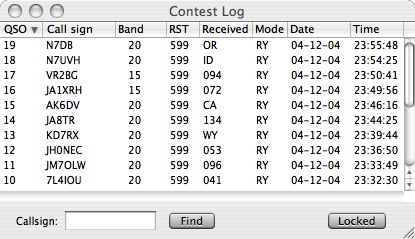
Contest Log reverse sorted by QSO Number
Notice that the above figure also shows the Time column dragged all the way to the right.
In addition to sorting by QSO number, you can click on the header of the Call sign column to sort by call sign (or reverse sort by call sign by reversing the small arrow’s direction). This is a good way to see how many bands you have worked a station on (the next section shows how to search for a call sign).
You can also click on the Band header to sort or reverse sort the QSOs by band.
The contest log’s window position, the column ordering and column widths are saved in your preference file when you quit cocoaModem.
Searching the Log
You can search for a call sign in the log. Enter the call sign in the Callsign text field and either type Return or click on the Find button. If the call sign is not found, a Not Found message will be printed next to the Find button. If the call sign is found, it will be highlighted in the log.
Clicking on the Find button after a call sign is found will search for the next occurrence of the call sign. When there are no more entries with the same call sign, a No more message will appear next to the Find button.
Editing the Log
For safety reasons, the log is locked to prevent editing. Clicking on the Locked button should turn the button indicator into the Unlocked state. In the unlocked state, you are allowed to edit the Call sign, Band, RST, Received exchange and Mode fields. The QSO number, time and date fields cannot be modified. As a precaution against accidentally altering the log, lock the log when you are done with editing (the locked is the default state).
You cannot remove an entire QSO entry when you have logged it. However, you can delete the entire Call sign field (after unlocking the log) and cocoaModem will replace it with a NIL callsign. When a Cabrillo log is created, all the QSO will NIL as callsigns will be omitted.
HINT: you can enter NIL into the call sign field of the Contest Interface and it will appear as NIL in the log and thus not appear in the final Cabrillo log. Note that a second NIL will cause a “DUPE” warning; just ignore it.
Creating a Cabrillo log File
Please read Contest Info Sheet section before you create the Cabrillo log.
To create a Cabrillo log, read your contest log file (XML format) by selecting Resume… in the Contest menu. After which, select Create Cabriilo from the Contest menu.
cocoaModem should generate a text file with the name W7AY.log, with your call sign (or the call sign you have used in the contest) in place of W7AY.
Implemented Contests
The following are contests which cocoaModem supports with templates and Cabrillo generation:
ARRL RTTY Roundup (January)
BARTG Sprint (January)
XE (Mexico) RTTY (February)
WPX RTTY (February)
BARTG RTTY HF (March)
TARA RTTY Melee (December)
- ARRL RTTY Roundup
With the RTTY Roundup, a state/province multiplier table is available. To display the mult table, select Show Mults in the Contest menu in the Menu bar. This will show a list of states and provinces:
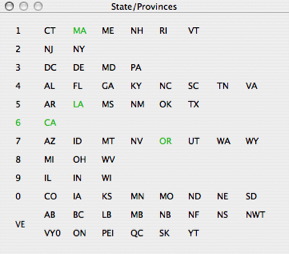
When a state or province is worked, its entry in the mult window will turn green. The window is closed by using the red close button at the left of the window’s title bar.
Quick Guide - Contesting Checklist
This checklist is a quick guide for setting up cocoaModem for a contest, operating, recovering from crashes, and log submission.
You should first read the Contest Interface section above to learn about aspects of the contest interface (e.g., log, AppleScripts, etc) that are not mentioned here.
Before the contest - Preparations
This step shows how you would set up the correct database for your station, and prepare a customized prototype contest template for yourself.
Start with a freshly launched copy of cocoaModem, then follow the following steps.
- - Open and fill in the data
in the User Info Panel. This panel is
opened by selecting User Info in the cocoaModem
Window menu.
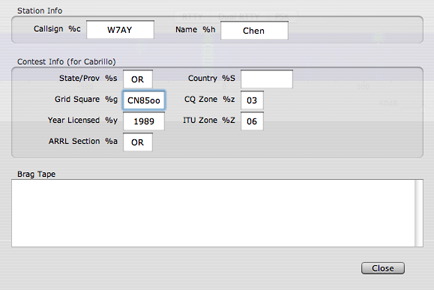
User Info Panel
If you are in the USA/Canada, fill in the State/Prov field with the two letter abbreviation for your state or province (or 3 letter abbreviation for Canadian territories).
If you are a DX (non-USA, non-Canadian), either leave the State/Prov field empty or fill it with “DX” (without the quotes), and leave the ARRL Section field empty.
Close the panel (close button) when you are done.
NOTE: the fields in the User Info panel are meant to be quite permanent – you should not need to change them from contest to contest - and they are saved to your Preferences (“plist”) file. In a contest where you are going to use a different call sign, you can override the call sign in the User Info panel by the “Call sign used” field in the Contest Info Panel (mentioned below). - - Open and fill in the data
in the Contest Info Panel. This panel is
opened by selecting Contest Info in the cocoaModem
Window menu.
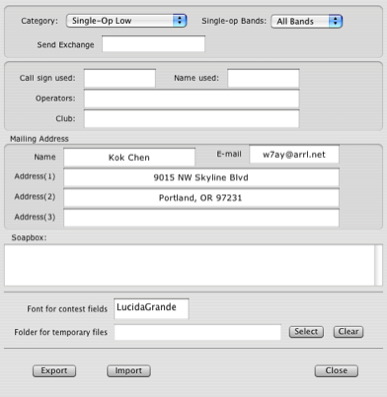
Contest Info Panel
Select the contest category that you wish to operate (single op low power, single op high power, multi-op, etc). If you have chosen a single-op category, whether low or high power, you will also have to select one of the band categories (all bands, 15 meters only, etc). If you are not operating single op, this second menu is ignored (“all band” is assumed).
The contest category fields are used later when generating the Cabrillo (contest entry) file.
For the contests that cocoaModem supports (the ones that are listed under the New item in the Contest menu of the cocoaModem menu bar), you can leave the Send Exchange field empty.
If you are using your regular call sign that is entered in your User Info, you can leave the Call sign used field empty. Otherwise, this field should contain the call sign that you are using in a contest.
If this field is not empty, use of the %c contest macro will fetch the string from this Call sign used field in the Contest Info panel instead of fetching from the Callsign field that is the User Info panel. This field is also used when generating the Cabrillo output.
Similarly, if the Name used field is not empty, using a %h inside a contest macro will fetch the string from the Name used field here instead of the Name field of the User Info panel. You can ignore this field for contests that don’t require names, or if you don't use the %h macro.
If you intend to submit a Cabrillo log to the contest manager, you should also fill in the Operators, Club and Mailing address fields now.
The Operators field should be a list of call sign of operators who had operated the contest. The call signs in the list should be separated from one another with space characters. If you had operated as single op, you can leave this field empty. However, if you had operated the contest using a different call sign from your own, it is advisable to fill in the operator’s own call sign so that the contest results will credit the proper operator.
The Club field should be filled in case you want your contest club to be credited with your score. Confirm with your club officers what the precise name to use is. The Cabrillo robot has been known to bounce a contest entry which includes an unknown club name/abbreviation.
The Mailing address (and e-mail address) fields are also only needed if you are submitting a log to the contest manager. This is where awards (and possibly questions about your log) are sent to.
The Soapbox field is where you can enter a short comment or observation. This is where QST, for example, gets the quotes from contesters from when it publishes the contest results.
The Font for contest fields is how you can change the font and font size of the text that shows in the fields (call sign, RST, exchange, etc) of the contest interface. You don’t type into this field, however. What you should do is to select the field (click or double click on the field). Then go to the Font menu in the menu bar and select Show Fonts (or use the keyboard shortcut option-command-T) to display the MacOS X Font Picker. You can then select the font and the size of the font there. When you are done, the text in the Font for contest fields will show the name of the font displayed in the font and font size that you have selected.
The last field (Folder for temporary files) in the Contest Info Panel is perhaps the most important field of all. It might be able to save you from crashes.
cocoaModem has a journaling mechanism built into it. Each time you work and then log a QSO, cocoaModem can write out the QSO log to a file. This journal file is updated to the disk right after every QSO. The content of the Folder for temporary files field tells cocoaModem whether to maintain this journal. If the field is empty (the default state when you run cocoaModem for the first time) cocoaModem will not create a journal file.
It is a good idea to inspect this file with an editor (BBEdit, TextEdit, etc) occasionally during the contest to see that it does contain all of your QSOs up to that point. Make sure you don’t make any changes to it! And also close the file after you are done inspecting it.
- Before the contest - Preparations